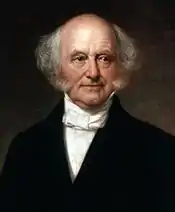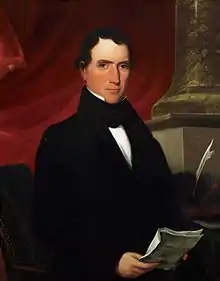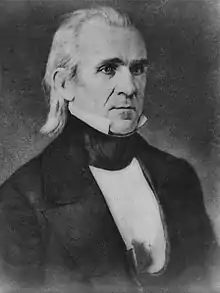24th United States Congress
The 24th United States Congress was a meeting of the legislative branch of the United States federal government, consisting of the United States Senate and the United States House of Representatives. It met in Washington, D.C. from March 4, 1835, to March 4, 1837, during the seventh and eighth years of Andrew Jackson's presidency. The apportionment of seats in the House of Representatives was based on the Fifth Census of the United States in 1830. Both chambers had a Jacksonian majority.
| 24th United States Congress | |
|---|---|
23rd ← → 25th | |
 United States Capitol (1827) | |
March 4, 1835 – March 4, 1837 | |
| Members | 52 senators 242 representatives 3 non-voting delegates |
| Senate Majority | Jacksonian |
| Senate President | Martin Van Buren (J) |
| House Majority | Jacksonian |
| House Speaker | James K. Polk (J) |
| Sessions | |
| 1st: December 7, 1835 – July 4, 1836 2nd: December 5, 1836 – March 3, 1837 | |
Major events
- December 28, 1835: The Second Seminole War began. Seminole fighter Osceola and his warriors attack government agent Thompson outside Fort King in central Florida.
- 1835: Toledo War fought between Ohio and Michigan Territory over the city of Toledo and the Toledo Strip.
- February 3, 1836: United States Whig Party held its first convention in Albany, New York.
- February 23, 1836: Siege of the Alamo began in San Antonio, Texas.
- July 11, 1836: President Andrew Jackson issued the Specie Circular, beginning the failure of the land speculation economy that would lead to the Panic of 1837.
- July 13, 1836: United States patent #1 was granted after filing 9,957 unnumbered patents.
- November 3 – December 7, 1836: 1836 presidential election: Martin Van Buren defeated William Henry Harrison, but Virginia's electors refused to vote for Van Buren's running mate, Richard Mentor Johnson, thereby denying victory to any vice presidential candidate.
- December 4, 1836: Whig Party held its first national convention, in Harrisburg, Pennsylvania.
- December 15, 1836: 1836 U.S. Patent Office fire
- February 8, 1837: Richard Mentor Johnson defeated Francis Granger to win the (first and to date only) contingent election for Vice President of the United States.[1][2]
Major legislation
- July 4, 1836: Patent Act of 1836, Pub.L. 24–357, 5 Stat. 117 [data unknown/missing]
Treaties
- December 29, 1835: Treaty of New Echota signed, ceding all the lands of the Cherokee east of the Mississippi to the United States
States admitted and territories formed
Party summary
The count below identifies party affiliations at the beginning of the first session of this congress. Changes resulting from subsequent replacements are shown below in the "Changes in membership" section.
Senate
During this congress two Senate seats were added for each of the new states of Arkansas and Michigan.[3][4]
| Party (shading shows control) |
Total | Vacant | |||
|---|---|---|---|---|---|
| Anti- Jacksonian (AJ) |
Jacksonian (J) | Nullifier (N) | |||
| End of previous congress | 26 | 20 | 2 | 48 | 0 |
| Begin | 24 | 21 | 2 | 47 | 1 |
| End | 19 | 31 | 52 | 0 | |
| Final voting share | 36.5% | 59.6% | 3.8% | ||
| Beginning of next congress | 19[lower-alpha 1] | 33[lower-alpha 2] | 0 | 52 | 0 |
House of Representatives
During this congress one House seat was added for each of the new states of Arkansas and Michigan.[3][4]
| Party (shading shows control) |
Total | Vacant | |||||
|---|---|---|---|---|---|---|---|
| Anti- Jacksonian (AJ) |
Anti- Masonic (AM) | Jacksonian (J) | Nullifier (N) | States' Rights (SR) | |||
| End of previous congress | 64 | 26 | 141 | 8 | 0 | 239 | 1 |
| Begin | 75 | 16 | 140 | 7 | 0 | 238 | 2 |
| End | 79 | 15 | 139 | 1 | 241 | 1 | |
| Final voting share | 32.8% | 6.2% | 57.7% | 2.9% | 0.4% | ||
| Beginning of next congress | 100[lower-alpha 3] | 7 | 121[lower-alpha 4] | 6 | 0 | 234 | 0 |
Members
This list is arranged by chamber, then by state. Senators are listed by class, and Representatives are listed by district.
Senate
Senators were elected by the state legislatures every two years, with one-third beginning new six-year terms with each Congress. Preceding the names in the list below are Senate class numbers, which indicate the cycle of their election. In this Congress, Class 1 meant their term began in the last Congress, requiring re-election in 1838; Class 2 meant their term began with this Congress, requiring re-election in 1840; and Class 3 meant their term ended with this Congress, requiring re-election in 1836.
Alabama
Arkansas
Connecticut
Delaware
Georgia
Illinois
Indiana
Kentucky
Louisiana
Maine
Maryland
Massachusetts
Michigan
|
Mississippi
Missouri
New Hampshire
New Jersey
New York
North Carolina
Ohio
Pennsylvania
Rhode Island
South Carolina
Tennessee
Vermont
Virginia
|
House of Representatives
The names of members of the House of Representatives are preceded by their district numbers.
Changes in membership
The count below reflects changes from the beginning of the first session of this Congress.
Senate
- Replacements: 11
- Anti-Jacksonians: 5-seat net loss
- Jacksonians: 10-seat net gain
- Deaths: 3
- Resignations: 8
- Interim appointments: 0
- Seats of newly admitted states: 4
- Total seats with changes: 16
| State (class) |
Vacator | Reason for change | Successor | Date of successor's formal installation[lower-alpha 5] |
|---|---|---|---|---|
| Louisiana (2) |
Vacant | Senator-elect Charles E.A. Gayarre had resigned on account of ill-health. Successor was elected January 13, 1836. |
Robert C. Nicholas (J) | January 13, 1836 |
| Connecticut (1) |
Nathan Smith (AJ) | Died December 6, 1835 Successor was elected December 21, 1835. |
John M. Niles (J) | December 21, 1835. |
| Illinois (3) |
Elias Kane (J) | Died December 12, 1835 Successor was appointed December 30, 1835. |
William Lee D. Ewing (J) | December 30, 1835 |
| Virginia (1) |
John Tyler (AJ) | Resigned February 29, 1836 Successor was elected March 4, 1836. |
William C. Rives (J) | March 4, 1836 |
| Maine (1) |
Ether Shepley (J) | Resigned March 3, 1836 Successor was appointed December 7, 1836. |
Judah Dana (J) | December 7, 1836 |
| New Hampshire (3) |
Isaac Hill (J) | Resigned May 30, 1836, to become Governor of New Hampshire. Successor was elected June 8, 1836. |
John Page (J) | June 8, 1836 |
| Delaware (1) |
Arnold Naudain (AJ) | Resigned June 16, 1836 Successor was elected June 17, 1836. |
Richard H. Bayard (AJ) | June 17, 1836 |
| Virginia (2) |
Benjamin W. Leigh (AJ) | Resigned July 4, 1836 Successor was elected December 12, 1836. |
Richard E. Parker (J) | December 12, 1836 |
| Arkansas (2) |
New seats | Arkansas was admitted to the Union. Its new Senators were elected September 18, 1836. |
William S. Fulton (J) | September 18, 1836. |
| Arkansas (3) |
Ambrose H. Sevier (J) | September 18, 1836. | ||
| Maryland (3) |
Robert H. Goldsborough (AJ) | Died October 5, 1836 Successor was elected December 31, 1836. |
John S. Spence (AJ) | December 31, 1836 |
| North Carolina (3) |
Willie P. Mangum (AJ) | Resigned November 26, 1836 Successor was elected December 5, 1836. |
Robert Strange (J) | December 5, 1836 |
| Delaware (2) |
John M. Clayton (AJ) | Resigned December 29, 1836 Successor was elected January 9, 1837. |
Thomas Clayton (AJ) | January 9, 1837 |
| Louisiana (3) |
Alexander Porter (AJ) | Resigned January 5, 1837, due to ill health. Successor was elected January 12, 1837. |
Alexandre Mouton (J) | January 12, 1837 |
| Michigan (1) |
New seats | Michigan was admitted to the Union. Its new Senators were elected January 6, 1837. |
Lucius Lyon (J) | January 26, 1837. |
| Michigan (2) |
John Norvell (J) | January 26, 1837. |
House of Representatives
- Replacements: 18
- Anti-Jacksonians: 5-seat net gain
- Anti-Masonics: 1-seat net loss
- Jacksonians: 2-seat net loss
- Nullifiers: No net change
- Deaths: 5
- Resignations: 13
- Contested election: 0
- Seats of newly admitted states: 2
- Total seats with changes: 24
| District | Vacator | Reason for change | Successor | Date of successor's formal installation[lower-alpha 5] |
|---|---|---|---|---|
| South Carolina 6 | Vacant | Rep. Warren R. Davis died during previous congress | Waddy Thompson, Jr. (AJ) | Seated September 10, 1835 |
| Georgia at-large | Vacant | Rep. James M. Wayne resigned in previous congress | Jabez Y. Jackson (J) | Seated October 5, 1835 |
| Georgia at-large | William Schley (J) | Resigned July 1, 1835 when nominated for Governor of Georgia. | Jesse F. Cleveland (J) | Seated October 5, 1835 |
| Georgia at-large | James C. Terrell (J) | Resigned July 8, 1835, due to ill health | Hopkins Holsey (J) | Seated October 5, 1835 |
| Georgia at-large | John W. A. Sanford (J) | Resigned July 25, 1835, to assist in the Cherokee Indian removal | Thomas Glascock (J) | Seated October 5, 1835 |
| New York 3 | Campbell P. White (J) | Resigned October 2, 1835 | Gideon Lee (J) | Seated November 4, 1835 |
| Connecticut at-large | Zalmon Wildman (J) | Died December 10, 1835 | Thomas T. Whittlesey (J) | Seated April 29, 1836 |
| South Carolina 4 | James H. Hammond (N) | Resigned February 26, 1836, because of ill health | Franklin H. Elmore (N) | Seated December 10, 1836 |
| New York 17 | Samuel Beardsley (J) | Resigned March 29, 1836 | Rutger B. Miller (J) | Seated November 9, 1836 |
| North Carolina 12 | James Graham (AJ) | Seat declared vacant March 29, 1836 | James Graham (AJ) | Seated December 5, 1836 |
| Pennsylvania 24 | John Banks (AM) | Resigned March 31, 1836 | John J. Pearson (AJ) | Seated December 5, 1836 |
| South Carolina 8 | Richard I. Manning (J) | Died May 1, 1836 | John P. Richardson (J) | Seated December 19, 1836 |
| Arkansas Territory at-large | Ambrose H. Sevier (J) | Seat was eliminated when Arkansas achieved statehood June 15, 1836 | ||
| Connecticut at-large | Andrew T. Judson (J) | Resigned July 4, 1836 to become judge of the United States District Court for the District of Connecticut. | Orrin Holt (J) | Seated December 5, 1836 |
| Mississippi at-large | David Dickson (AJ) | Died July 31, 1836 | Samuel J. Gholson (J) | Seated December 1, 1836 |
| Arkansas at-large | Vacant | Arkansas was admitted to the Union on June 15, 1836 | Archibald Yell (J) | Seated August 1, 1836 |
| Georgia at-large | George W. Towns (J) | Resigned September 1, 1836 | Julius C. Alford (AJ) | Seated January 2, 1837 |
| New York 30 | Philo C. Fuller (AJ) | Resigned September 2, 1836 | John Young (AJ) | Seated November 9, 1836 |
| Georgia at-large | John E. Coffee (J) | Died September 25, 1836 | William C. Dawson (AJ) | Seated November 7, 1836 |
| Pennsylvania 13 | Jesse Miller (J) | Resigned October 30, 1836 | James Black (J) | Seated December 5, 1836 |
| New Jersey at-large | Philemon Dickerson (J) | Resigned November 3, 1836 to become Governor of New Jersey. | William Chetwood (AJ) | Seated December 5, 1836 |
| Indiana 6 | George L. Kinnard (J) | Died November 26, 1836 | William Herod (AJ) | Seated January 25, 1837 |
| Virginia 2 | John Y. Mason (J) | Resigned January 11, 1837 | Vacant | Not filled this congress |
| Michigan Territory at-large | George Wallace Jones (J) | Seat was eliminated when Michigan achieved statehood January 26, 1837 | ||
| Michigan at-large | Vacant | Michigan was admitted to the Union on January 26, 1837 | Isaac E. Crary (J) | Seated January 26, 1837 |
| Wisconsin Territory at-large | Vacant | Wisconsin Territory was organized on April 3, 1836 | George Wallace Jones (J) | Seated January 26, 1837 |
Committees
Lists of committees and their party leaders.
Senate
- Agriculture (Chairman: Bedford Brown then John Page)
- Audit and Control the Contingent Expenses of the Senate (Chairman: Samuel McKean)
- Claims (Chairman: Arnold Naudain then Henry Hubbard)
- Commerce (Chairman: Robert Henry Goldsborough then John Davis)
- Constitution of the State of Arkansas (Select)
- Distributing Public Revenue Among the States (Select)
- District of Columbia (Chairman: John Tyler then Joseph Kent)
- Engrossed Bills (Chairman: Ether Shepley then Thomas Morris)
- Finance (Chairman: Daniel Webster then Silas Wright)
- Foreign Relations (Chairman: Henry Clay then James Buchanan)
- Incendiary Publications (Select)
- Indian Affairs (Chairman: Hugh Lawson White then Ambrose Sevier)
- Judiciary (Chairman: John M. Clayton then Felix Grundy)
- Letter from Mr. Poindexter (Select)
- Manufactures (Chairman: Nehemiah Knight)
- Mileage of Members of Congress (Select)
- Military Affairs (Chairman: Thomas Hart Benton)
- Militia (Chairman: John M. Robinson)
- Naval Affairs (Chairman: Samuel Southard then William C. Rives)
- Ohio-Michigan Boundary (Select)
- Patent Office (Select)
- Pensions (Chairman: Gideon Tomlinson)
- Post Office and Post Roads (Chairman: Felix Grundy)
- Private Land Claims (Chairman: John Black then Lewis Linn)
- Public Lands (Chairman: Thomas Ewing then Robert J. Walker)
- Purchasing Boyd Reilly's Gas Apparatus (Select) (Chairman: N/A)
- Revolutionary Claims (Chairman: Gabriel Moore then Bedford Brown)
- Roads and Canals (Chairman: William Hendricks)
- Sale of Public Lands (Select)
- Tariff Regulation (Select)
- Whole
House of Representatives
- Accounts (Chairman: N/A)
- Agriculture (Chairman: Abraham Bockee)
- Amendment to the Constitution (Select)
- Banks of the District of Columbia (Select)
- Claims (Chairman: N/A)
- Commerce (Chairman: N/A)
- District of Columbia (Chairman: N/A)
- Elections (Chairman: N/A)
- Expenditures in the Navy Department (Chairman: N/A)
- Expenditures in the Post Office Department (Chairman: N/A)
- Expenditures in the State Department (Chairman: N/A)
- Expenditures in the Treasury Department (Chairman: N/A)
- Expenditures in the War Department (Chairman: N/A)
- Expenditures on Public Buildings (Chairman: N/A)
- Foreign Affairs (Chairman: Benjamin C. Howard)
- Indian Affairs (Chairman: N/A)
- Invalid Pensions (Chairman: N/A)
- Judiciary (Chairman: Samuel Beardsley then Francis Thomas)
- Manufactures (Chairman: N/A)
- Military Affairs (Chairman: N/A)
- Militia (Chairman: N/A)
- Naval Affairs (Chairman: N/A)
- Post Office and Post Roads (Chairman: N/A)
- Public Expenditures (Chairman: N/A)
- Public Lands (Chairman: Ratliff Boon)
- Revisal and Unfinished Business (Chairman: N/A)
- Revolutionary Claims (Chairman: N/A)
- Roads and Canals (Chairman: N/A)
- Rules (Select)
- Standards of Official Conduct
- Territories (Chairman: N/A)
- Ways and Means (Chairman: Churchill C. Cambreleng)
- Whole
Joint committees
- Enrolled Bills
- The Library
Employees
Senate
- Chaplain: Frederick Winslow Hatch (Episcopalian), until December 23, 1835
- Edward Y. Higbee (Episcopalian), elected December 23, 1835
- John R. Goodman (Episcopalian), elected December 28, 1836
- Secretary: Walter Lowrie until December 11, 1836
- Asbury Dickins, elected December 12, 1836
- Sergeant at Arms: John Shackford
House of Representatives
- Chaplain: Edward Dunlap Smith (Presbyterian), until December 7, 1835
- Thomas H. Stockton (Methodist), elected December 7, 1835
- Oliver C. Comstock (Baptist), elected December 5, 1836
- Clerk: Walter S. Franklin
- Doorkeeper: Overton Carr
- Sergeant at Arms: Thomas B. Randolph, until December 15, 1835
- Roderick Dorsey, elected December 15, 1835
- Reading Clerks: [data unknown/missing]
- Postmaster: William J. McCormick
See also
- 1834 United States elections (elections leading to this Congress)
- 1836 United States elections (elections during this Congress, leading to the next Congress)
Notes
References
- "Cong. Globe, 24th Cong., 2nd Sess. 166 (1837)". A Century of Lawmaking for a New Nation: U.S. Congressional Documents and Debates, 1774–1875. Washington, D.C.: Library of Congress. Retrieved August 10, 2019.
- "The Senate Elects a Vice President". Washington, D.C.: Office of the Secretary of the Senate. Retrieved August 11, 2019.
- 5 Stat. 50
- 5 Stat. 144
- Martis, Kenneth C. (1989). The Historical Atlas of Political Parties in the United States Congress. New York: Macmillan Publishing Company.
- Martis, Kenneth C. (1982). The Historical Atlas of United States Congressional Districts. New York: Macmillan Publishing Company.


